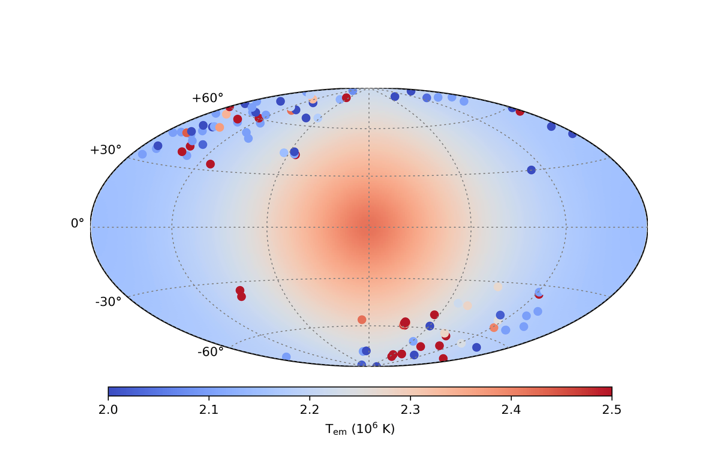A Novel Method to Weigh the Milky Way with Its “Missing” Baryons
The Milky Way (MW), the Galaxy that we reside in, contains many mysteries. Astronomical observations have provided strong evidence that the Galaxy is dominated by dark matter, while the normal matter, the baryons, only accounts for a small fraction of about 6% of the total gravitating matter, which is even significantly lower than the cosmic baryon fraction of about 16% predicted by the Big Bang nucleosynthesis theory. A key step toward solving this mystery is the precise measurement of the total mass of the Milky Way.
Recently, a research group led by Prof. GUO Fulai at Shanghai Astronomical Observatory (SHAO) of the Chinese Academy of Sciences has presented a novel method to measure the MW mass based on the temperature measurements of the hot diffuse gas in the MW halo. The study was published in The Astrophysical Journal Letters.
A novel method to measure the MW mass
Previous measurements of the MW mass have been mainly based on the observed rotational or random velocities of stars, globular clusters, and satellite galaxies in the disk and halo of the Galaxy. The higher the MW mass, the faster these collisionless objects move in equilibrium. The measured MW mass so far is around a trillion times the mass of the Sun, with uncertainties of more than a factor of two on both the lower and higher mass sides.
The novel method proposed by GUO and his team uses the hot halo gas as the tracer of the Milky Way mass. Since 1950s, astronomers have found many different pieces of evidence indicating that a diffuse, million-degree hot gaseous halo surrounds the MW galaxy, possibly extending to a distance of several hundred thousands light years. The total mass of this halo gas is quite uncertain, but it may constitute a large fraction of the missing baryons in the Milky Way.
The research group at SHAO has investigated the spatial temperature and density distributions of the halo gas, its observational signatures, and its interplay with energetic processes in the MW during the past few years.
According to the study, the equilibrium gas temperature distribution, which the halo gas tends to settle to, is most sensitively affected by the MW mass, while the total halo gas mass and the abundances of heavy elements in the halo gas have nearly no impact. The higher the MW mass, the higher the halo gas temperature.
In this way, instead of velocity for collisionless objects, temperature becomes the key quantity for the collisional hot gas when measuring the MW mass. Based on the observed halo gas temperature from X-ray observations, the research group derived a new constraint on the MW mass. It is 1.2-3.0 trillion times the mass of the Sun.

Fig. 1. Line-of-sight averaged temperature distribution seen from the Earth predicted in a representative model of the MW halo gas (GUO et. al. 2020). The center of the image corresponds to the Galactic center. The predicted halo gas temperature is around 2.2 million Kelvin, consistent with the nearly uniform temperatures (dots) measured by the XMM-Newton X-ray Space Telescope (Henley & Shelton 2013). Image adapted from GUO et al. (2020).
Important implications of the newly measured MW mass
The MW mass measured by the new method is higher than a trillion times the mass of the Sun, which has far-reaching important implications.
First, it implies that large satellite galaxies of the MW, such as the Magellanic Clouds and the Leo I dwarf spheroidal, are bound to the MW. They would be unbound if the MW mass is much lower.
Second, it implies that a large fraction of baryons are missing in the MW, even when the hot halo gas is taken into account. These missing baryons may reside beyond the MW halo or in a cool phase that has not yet been detected. If the MW mass is much lower than a trillion times the solar mass, the missing baryon problem of the MW would simply disappear.
Third, it implies that the so called “too-big-to-fail” problem in contemporary cosmology is still severe, potentially challenging the cold dark matter theory in the standard paradigm of cosmology. The standard model of cosmology predicts that the MW should have several satellite galaxies much denser and more massive than those currently observed. The inconsistency would have been resolved if the MW mass is substantially lower than a trillion times the solar mass.
“The most important contribution of our work is perhaps that it provides an independent way to measure the MW mass, which can be constrained much more stringently when combining with previous kinetic methods,” concluded lead author GUO.
Science Contact: GUO Fulai, Shanghai Astronomical Observatory, Chinese Academy of Sciences, fulai@shao.ac.cn
News Contact: ZUO Wenwen, Shanghai Astronomical Observatory, Chinese Academy of Sciences, wenwenzuo@shao.ac.cn, 021-34775125
Link to the Scientific Work: https://iopscience.iop.org/article/10.3847/2041-8213/abc749Download attachments: